Plant biosecurity
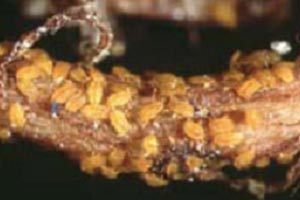
On this page:
Fruit flies
Fruit flies are small insects that pose big risks to most commercial fruit and vegetable crops.
ACT monitoring program
The ACT Government monitors for fruit flies to protect orchards and home fruit growers within the ACT as well as surrounding regions with large fruit growing areas, such as Young, Batlow and the Riverina.
The ACT monitors for three specific types of fruit fly: The Queensland Fruit Fly, Mediterranean Fruit fly and Exotic Fruit fly. Monitoring occurs in 10 locations across Canberra from early Spring until late Autumn, with support from the NSW Department of Primary Industries on species identification.
The ACT has not had a positive sample for Mediterranean Fruit fly and Exotic Fruit fly in recent years and the Queensland Fruit fly has been in decline since 2020.
The ongoing monitoring program is part of the National Plant Health Surveillance Program coordinated by the Department of Agriculture Fisheries and Forestry which supports interjurisdictional coordination on biosecurity challenges.
Help stop the spread
To help stop the spread and protect food growing regions in and around the ACT:
- Dispose of all fruit appropriately. Pick up dropped fruit from fruit trees and place in a bag before disposing and never throw fruit out of the car window.
- Do not interfere with any fruit fly traps hanging in trees within parks and reserves.
If you suspect fruit flies may be in your fruit trees, contact ACTBiosecurity@act.gov.au for advice.

Images thanks to Department of Agriculture, Forestry and Fisheries.
Giant Pine Scale
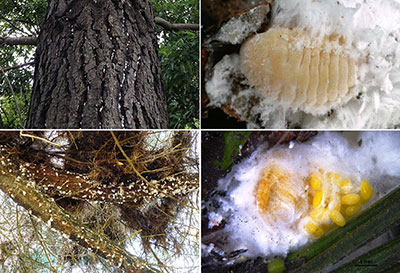
Heavily infested trees can dry up and die from the insects feeding on the tree's sap.
Current situation in Victoria
Giant pine scale is a tiny scale insect that lives by sucking the sap of pine, fir and spruce trees. Confirmed in Melbourne’s south-eastern suburbs for the first time in 2014, giant pine scale presents a new Biosecurity threat to softwood plantation industries. Heavily infested trees can dry up and die from the insects feeding on the tree’s sap, impacting pine trees in parks, softwood plantations and residential properties if not properly managed.
There are currently no effective chemical treatment options available for giant pine scale.
What to look for
Giant pine scale infested trees can be easily recognised by the white, cotton wool-like wax the insect produces that looks like snow on the tree’s trunks and branches. While the insect typically prefers the lower part of the tree (i.e. trunk), it can also be found on branches and exposed roots.
Help stop the spread
If you find giant pine scale on a pine, spruce or fir tree in the ACT report it to:
- Access Canberra on 13 22 81 or the Exotic Plant Pest Hotline 1800 084 881
- Email photos of the suspected pest, together with a contact phone number and the pest’s location to ACTBiosecurity@act.gov.au (Avoid collecting samples)
People can also unintentionally spread Giant pine scale when moving infested plant material (e.g. branches, mulch and logs), using contaminated gardening equipment and carrying it on clothing, machinery and cars. It is important to practise good plant and equipment hygiene to avoid spreading Giant pine scale.
Further information
- For more information see https://www.dpi.nsw.gov.au/biosecurity/plant/insect-pests-and-plant-diseases/giant-pine-scale
- Watch video at: https://youtu.be/nH7zGE4LBWA
- View the Giant pine scale Biosecurity Alert PDF
Coolatai Grass
Coolatai Grass is highly invasive of grassland, woodland and pasture, Coolatai grass is a drought, fire and herbicide tolerant tussock grass from Africa. It has become a major invasive species in northern New South Wales (NSW) and is spreading southwards. Infestations have been discovered to the north and south of the ACT.
Coolatai grass is capable of invading undisturbed natural ecosystems and is a major threat to biodiversity in nature reserves and national parks. It is also a threat to grazing productivity due to low levels of protein and digestability.
Phylloxera
Grapevine phylloxera, Daktulosphaira vitifoliae, is a small (up to 1mm long) aphid-like insect that lives and feeds exclusively on the roots of grapevines and occasionally in distinctive galls on grapevine leaves.
Phylloxera originates from eastern North America, where it lives on native grapevines. However, the insect is now present in most of the world's viticultural regions as a result of the movement of phylloxera-infested grapevines, especially in the late 1800s. European (Vitis vinifera) vines have little or no tolerance to phylloxera feeding and almost always die. The species is thus regarded as the world's worst grapevine pest.
Myrtle Rust (Uredo rangelii)
The rust caused by Uredo rangelii, which is known as Myrtle rust, was detected in Australia on 23 April 2010 on a cut flower growing property on the central coast of New South Wales. The rust was confirmed on Agonis flexuosa (willow myrtle), Syncarpia glomulifera (turpentine) and Callistemon (bottlebrush) species growing on and near the property.
Rusts are highly transportable. Their spores can be spread on contaminated clothing, infected plant material and equipment and by insect movement and wind dispersal. Fungi in the guava rust complex affect commercial plant growing operations and native ecosystems. They typically attack young plants and new growth on established plants.
For more information see the list of species being infected by Myrtle rust in NSW, Queensland and Victoria.
Some of these species may not occur in the ACT.
Sample photographs of myrtle rust are produced for identification.
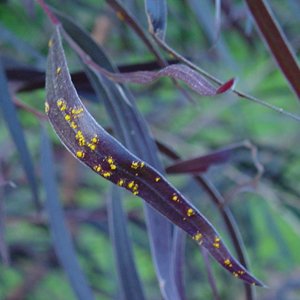
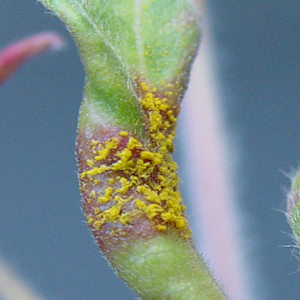
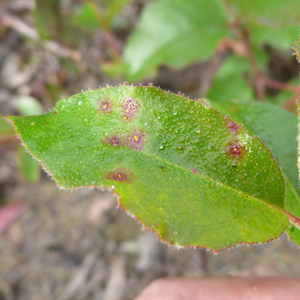
Elm Leaf Beetle
The Elm Leaf Beetle (Pyrrhalta luteola) can defoliate an elm tree in a week if untreated and currently poses the greatest threat to the elm tree population in Australia. First spotted in Australia in 1989, it has now spread throughout Victoria and several cases have been reported in the ACT. Read more on the elm leaf beetle.

